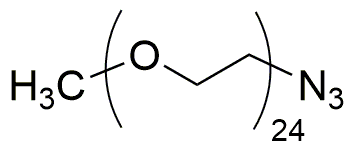Methyl-PEG24-azide is widely utilized in research focused on:
- Bioconjugation: This compound serves as a versatile linker in bioconjugation processes, allowing researchers to attach biomolecules like proteins or antibodies to surfaces or other molecules, enhancing the development of targeted therapies.
- Drug Delivery Systems: Its unique properties facilitate the creation of drug delivery systems that improve the solubility and stability of therapeutic agents, making treatments more effective and reducing side effects.
- Surface Modification: Methyl-PEG24-azide is used to modify surfaces of medical devices and implants, promoting biocompatibility and reducing protein adsorption, which is crucial for improving patient outcomes.
- Fluorescent Labeling: This compound can be employed in fluorescent labeling techniques, enabling researchers to track and visualize biological processes in real-time, which is essential in cellular biology studies.
- Polymer Chemistry: In polymer science, it acts as a building block for synthesizing functionalized polymers, leading to innovative materials with tailored properties for various applications, such as sensors and drug carriers.
General Information
Properties
Safety and Regulations
Applications
Methyl-PEG24-azide is widely utilized in research focused on:
- Bioconjugation: This compound serves as a versatile linker in bioconjugation processes, allowing researchers to attach biomolecules like proteins or antibodies to surfaces or other molecules, enhancing the development of targeted therapies.
- Drug Delivery Systems: Its unique properties facilitate the creation of drug delivery systems that improve the solubility and stability of therapeutic agents, making treatments more effective and reducing side effects.
- Surface Modification: Methyl-PEG24-azide is used to modify surfaces of medical devices and implants, promoting biocompatibility and reducing protein adsorption, which is crucial for improving patient outcomes.
- Fluorescent Labeling: This compound can be employed in fluorescent labeling techniques, enabling researchers to track and visualize biological processes in real-time, which is essential in cellular biology studies.
- Polymer Chemistry: In polymer science, it acts as a building block for synthesizing functionalized polymers, leading to innovative materials with tailored properties for various applications, such as sensors and drug carriers.
Documents
Safety Data Sheets (SDS)
The SDS provides comprehensive safety information on handling, storage, and disposal of the product.
Product Specification (PS)
The PS provides a comprehensive breakdown of the product’s properties, including chemical composition, physical state, purity, and storage requirements. It also details acceptable quality ranges and the product's intended applications.
Certificates of Analysis (COA)
Search for Certificates of Analysis (COA) by entering the products Lot Number. Lot and Batch Numbers can be found on a product’s label following the words ‘Lot’ or ‘Batch’.
*Catalog Number
*Lot Number
Certificates Of Origin (COO)
This COO confirms the country where the product was manufactured, and also details the materials and components used in it and whether it is derived from natural, synthetic, or other specific sources. This certificate may be required for customs, trade, and regulatory compliance.
*Catalog Number
*Lot Number
Safety Data Sheets (SDS)
The SDS provides comprehensive safety information on handling, storage, and disposal of the product.
DownloadProduct Specification (PS)
The PS provides a comprehensive breakdown of the product’s properties, including chemical composition, physical state, purity, and storage requirements. It also details acceptable quality ranges and the product's intended applications.
DownloadCertificates of Analysis (COA)
Search for Certificates of Analysis (COA) by entering the products Lot Number. Lot and Batch Numbers can be found on a product’s label following the words ‘Lot’ or ‘Batch’.
*Catalog Number
*Lot Number
Certificates Of Origin (COO)
This COO confirms the country where the product was manufactured, and also details the materials and components used in it and whether it is derived from natural, synthetic, or other specific sources. This certificate may be required for customs, trade, and regulatory compliance.


